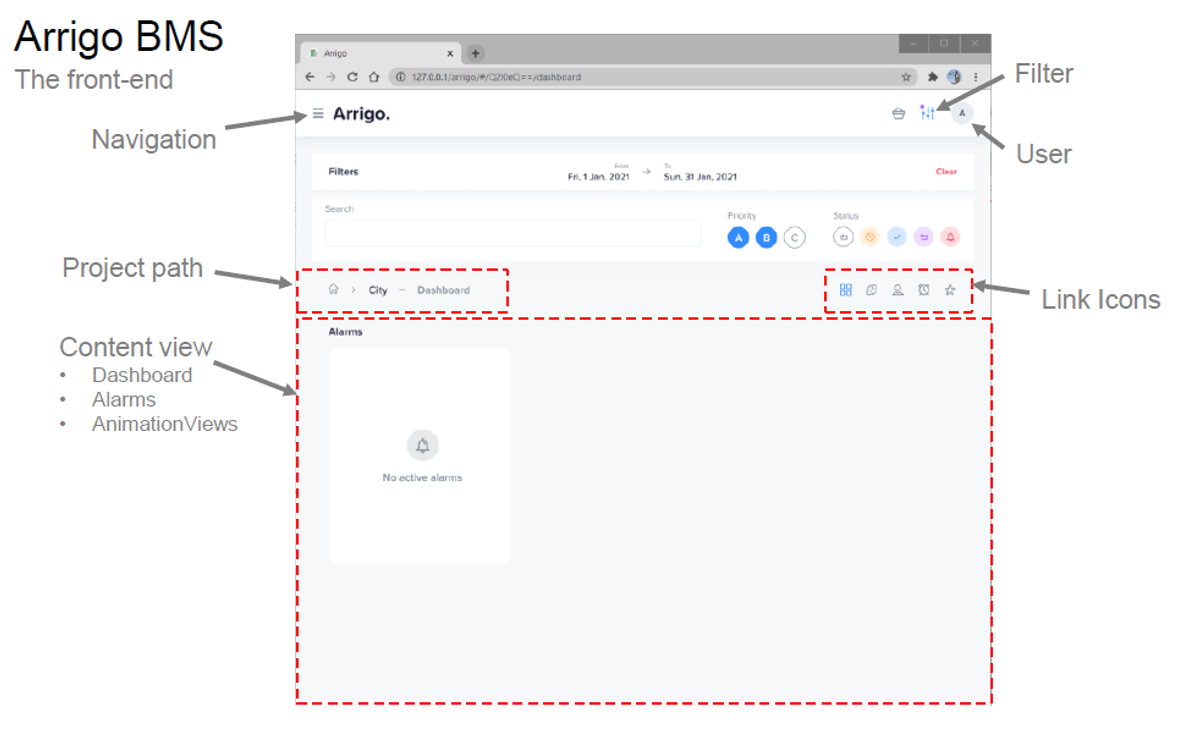About Arrigo Local
General
ArrigoLocal is a complete web-based BMS system developed for EXO hardware, but suitable for any system through an OPC and/or API link.
The main functions are:
-
Dynamic visualization of climate and processes
-
Unlimited historical data via a SQL database
-
Alarm overview with various filter functions
-
Time program settings
-
Adjustable heating curves
-
A large template library
-
Supports large server environments
-
Scalable and vector based graphics
Download the Arrigo Local Installer from the website releases.arrigo.se
Note
These instructions assume you are connected to the internet. If you require to do an air-gapped installation, please contact support.
Run the file and install the latest stable version automatically. To install the latest version (untested release) or to do a full reinstall, start the program from the command prompt (command prompt / cmd) with the following addition “latest” or “force”
“root”\ ArrigoLocalInstaller.exe - latest – force
ArrigoLocal uses IIS for the web application. You can activate a maximum of 1 project per computer. The following ports are used:
-
EXOline, communication between the controller and computer, over port 26486
-
HTTP traffic over port 80
-
SSL traffic over port 443 when using SSL encryption
The tools for creating the visualization do not require IIS settings or port configurations.
Arrigo runtime runs as a background service and normally starts automatically with Windows.
Via “Start EXOscada Services” it can be started manually via the Windows app. Simply right-click on the EXOscada icon in the windows systray.
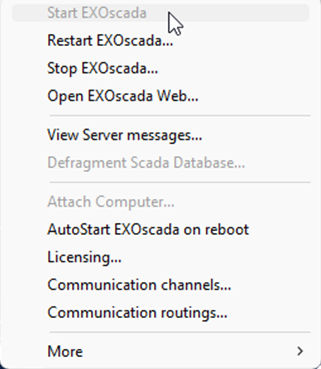
If no project has been connected (attached) yet, this can be done via “Attach Computer”.
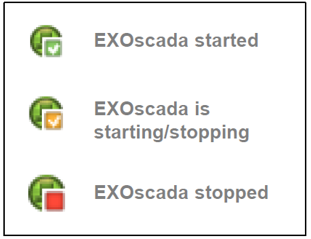
You also have to link Arrigo separately once per project. Open “EXOdesigner – Project Builder” and select “ArrigoBMS” on the left. Choose at pulldonw menu Tools “Arrigo – Attach project”. Ensure EXOscada is running.
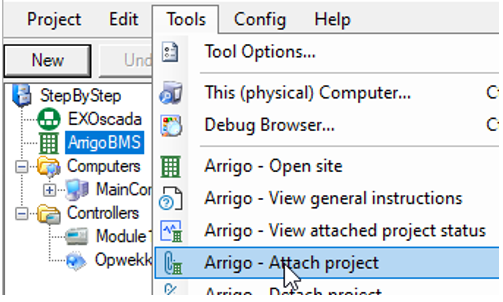
When EXOscada / Arrigo is started and you want to open your project locally in runtime then open the explorer and go to:
http://127.0.0.1/arrigo/ or localhost/arrigo/
The following usernames are created by default.
| Level | Username | Password | notes |
|---|---|---|---|
| System | Administrator | sysadmin | sysadmin (can delete and create users among other things) |
| Service | service | service | |
| Operator | operator | operator | |
| Guest | guest | guest | |
| Browse | browse | browse |
Database
The SQL database can run locally or remotely. In addition to the normal SQL enterprise, a free SQL Express version is available. The Express version can store a maximum of 10GB of data. The amount of data depends on the number of variables and the storage time of that variable. The SQL database must be installed separately.
In “EXOdesigner – Project Builder” under the “Maincomputer” you will find the tool to manually configure a number of database issues.
To limit the amount of data you can open the tool “Scada Action Categories”.
Configure data storage
-
Open EXOdesigner – Project Builder with your previously created project StepByStep
-
Click EXOscada
-
Go to the pulldown menu “Config” and choose “Scada Action Categories”
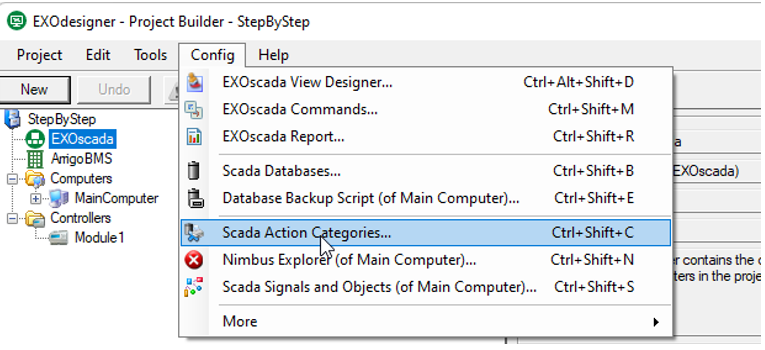

In the window above you will see 5 options on the left.
- AlarmClass A-B-C
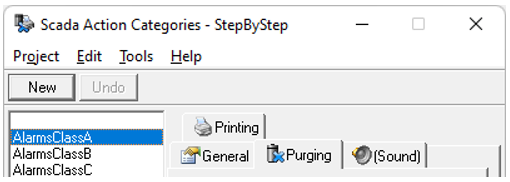
Here you will find various tabs with settings.
Under “Purging” you will find how long these priority alarms should be stored. For example, set it to 3 years.
Under “Printing” you can, as the word as says, configure the printer when, among other things, the rise or fall of the priority alarms. With the Nimbus option, a txt file is printed, which Nimbus then reads.
-
Event points are the digital circuits that are not alarms such as digital outputs for example.
-
LogSignals

LogSignals are all real variables configured in the “Logger” tool. We had set them very quickly in our exercise, at 1 minute. These minute values are stored for 1 month and then converted to hour values. So this is quite short. Set those values to “2 y”.
The (new) hour to day values are stored for 3 months. Adjust that to “5 y”.
The day to month values are stored 1 y. Adjust that to also “5 y”.
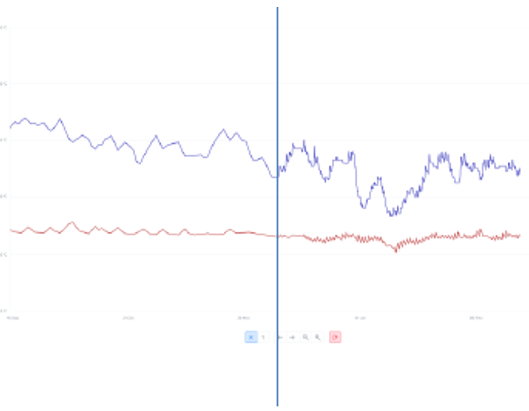
In the tab “Compilation” there are 3 values for “Periods” that are used for the previous tab. These are also used to create the reports.
Note
The database runs optimally up to a maximum size of 7 to 8 GB.
Dongles (licence keys)
In order to use Arrigo in runtime, a dongle (hardlock or software key) is often required. There are several dongles for Arrigo:
| License code | Rights |
|---|---|
| Without license key | All basic functions available, Max 75 I/O's, No network support between EXOscada/EXO4 computers, but full support between Arrigo and web browser, No connection to OPC-servers |
| EXODS Base (EXODS-B-1YR, EXODS-BSD-1YR) | All basic functions in EXOscada, max 200 I/O's, no connection to OPC-servers, no Nimbus alarm server |
| EXODS-100 | Supplements EXODS Base with an additional 1oo I/O's, can add multiple licenses |
| EXODS-500 | Supplements EXODS Base with an additional 5oo I/O's, can add multiple licenses |
| EXODS-ULIO | Supplements EXODS Base with an unlimited number of I/O's |
| EXODS-OPC | Supplements EXODS Base with one OPC-server connection |
| EXODS-Nimbus | Supplements EXODS Base with Nimbus Alarm Server support |
| EXODS-OPCDRIVER | Support for EXOopc Driver |
A dongle suitable for EXOscada 2019 is also suitable for Arrigo BMS 1.1.
Which dongle is required depends on the controllers used and a number of services. The number of I/O points can be requested via the main computer in the EXOdesigner tool. Select computer and press Show number of I/O points. 
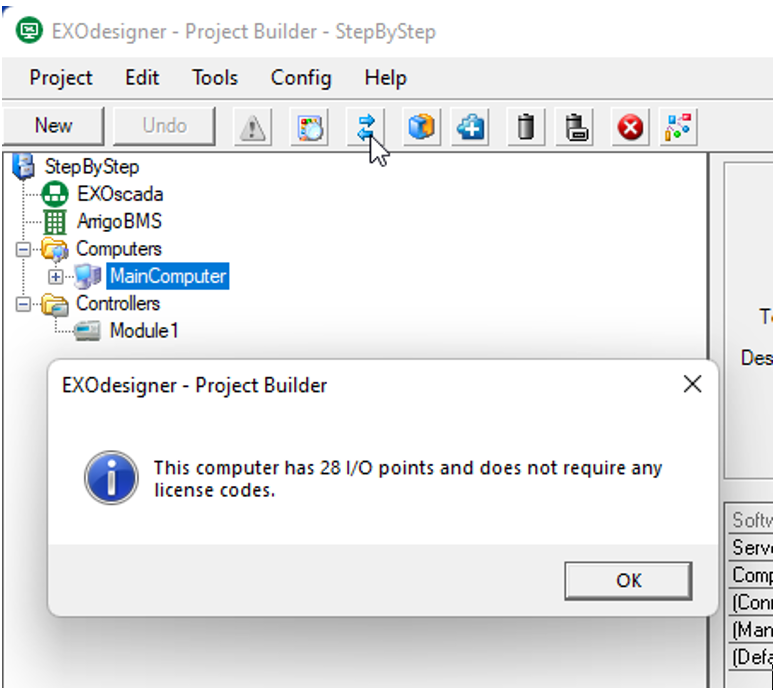
Folder Structure
The structure you create in EXOdesigner – ProjectBuilder is also the tree structure in Arrigo.

